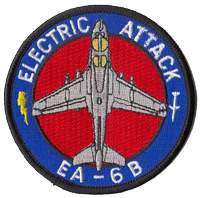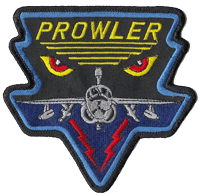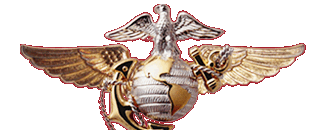MCARA Aircraft > EA-6B ICAP-I Prowler > History
Marine Corps EA-6B Improved Capability I (ICAP-I) Prowler History
After the withdrawal of US forces from Vietnam in 1973 it became apparent that either a major upgrade to the EA-6A Intruders was required or the service must transition to the Navy’s EA-6B which was in production at Grumman Aircraft Corporation. The first alternative considered by the D/CS Aviation was to follow the A-6A attack aircraft lead by upgrading the existing airframes to the new A-6E baseline and perhaps procure a few more while the production line was still open. NAVAIRSYSCOM was tasked to do a preliminary study which also included a badly need modernization of the EA-6A’s EW systems. The results of this study showed there were many drawbacks to this EA-6E alternative but it was viable. However, the end result would have left the Marine Corps still going it alone with a unique aircraft for a small but important community, at least in the eyes of senior Marine aviators such as BGen Phil Shutler, the assistant DC/S Aviation in 1974. However, DC/S Aviation was under intense pressure to reduce its share of the declining force levels and dropping the EW mission was pushed by those in the influential ground community who believe the Marine Corps should no longer devote its resources to supporting what they saw as a primary Air Force and Navy mission. The Navy also was against the idea of an EA-6E for the Marine Corps as they felt it would undermine their relatively new EA-6B program which also was under budget pressure, and frankly wanted the Marines to give up the mission to them. The distaste for such an idea was felt throughout the Marine Corps VMCJ community given the Navy’s late coming appreciation for a modern tactical EW aircraft, having stuck with the propeller driven EA-1F from Korea till the end of the Vietnam war when the EA-6B basic version entered service.
 The Navy did however appreciate the ability of the Marine Corps to go it alone with aircraft programs it really wanted using its political base in Congress. So, the Marine Corps was able to leverage the EA-6E option when dealing with the Navy and as a result forged a compromise solution that involved the Marine Corps accepting the EA-6B ICAP I variant with benefit of some design inputs, and sharing the planned inventory of EA-6Bs with the Navy under a memorandum of understanding starting with the FY-77 production. Later, the Navy was to exact another toll on the Marine Corps by getting an agreement that the first two VMAQ-2 detachments would serve back to back tours covering the USS Midway which was home ported in Japan, this after nearly 5 years of support by the EA-6As.
The Navy did however appreciate the ability of the Marine Corps to go it alone with aircraft programs it really wanted using its political base in Congress. So, the Marine Corps was able to leverage the EA-6E option when dealing with the Navy and as a result forged a compromise solution that involved the Marine Corps accepting the EA-6B ICAP I variant with benefit of some design inputs, and sharing the planned inventory of EA-6Bs with the Navy under a memorandum of understanding starting with the FY-77 production. Later, the Navy was to exact another toll on the Marine Corps by getting an agreement that the first two VMAQ-2 detachments would serve back to back tours covering the USS Midway which was home ported in Japan, this after nearly 5 years of support by the EA-6As.
There were several Marine officers that played key roles relating to the EA-6A follow-on program. Action officers in the requirements branch (AAW) of DC/S Aviation during the 1973-75 timeframe included Lt. Col Bob Farley, a former VMCJ-1 CO, Major Dave Weber, an ECMO who was on the first EA-6A Mediterranean det in 1971, and Lt. Col John Dailey, CO of VMCJ-1 during the Linebacker II operation, who had relieved Farley. Major Weber and Lt. Colonel Dailey (later ACMC) were also instrumental in the splitting of the VMCJs in 1975 into VMAQ-2 and VMFP-3. The DC/S Aviation during this timeframe was Major General Ed Fris and later BGen Shutler, who had played a key role in the initial EA-6A program.
Over at the Naval Air Systems Command, Lt. Colonel Tim Fallon was the EA-6A/EA-6B Systems Engineering or Class Desk officer, and Captain John Suhy was EW/ avionics systems projects officer and main contributor to the EA-6E study. Both were to become VMAQ-2 COs. Major Wayne Whitten was the USMC EW projects officer at the Naval Missile Center, Pt. Mugu, CA and after undergoing familiarization training in the EA-6B (EXCAP) aircraft served as the USMC representative on the EA-6B ICAP-I Fleet Project team with design oversight. Whitten was aided by Bob Tuleya, a retired Marine captain and EA-6A TSQ-90 (TERPES) project officer at Pt. Mugu, who was involved in processing and analyzing navigation and signal data from EA-6B on-board data recorders. Whitten relieved Weber as AAW-42 in June 1975, working for Lt. General Tom Miller, the DC/S Aviation during the transition to the EA-6B in 1977.
 To facilitate the transition to the EA-6B, a VMAQ-2 Detachment was formed at NAS Whidbey Island with administrative control over USMC aircrews and maintenance personnel undergoing training with VAQ-129. Lt. Colonel Royal Moore, former VMAQ-2 CO, was the CO of VMAQ Det Whidbey in 1976-1978, and Major Dave Weber became the CO of VMAQ-2 Det X which deployed to the USS Midway in December, 1978.
To facilitate the transition to the EA-6B, a VMAQ-2 Detachment was formed at NAS Whidbey Island with administrative control over USMC aircrews and maintenance personnel undergoing training with VAQ-129. Lt. Colonel Royal Moore, former VMAQ-2 CO, was the CO of VMAQ Det Whidbey in 1976-1978, and Major Dave Weber became the CO of VMAQ-2 Det X which deployed to the USS Midway in December, 1978.
Based on the agreement for sharing the FY-77 new production EA-6B ICAP-I aircraft, the first bureau number destined for the Marine Corps was 160432 which was due for delivery on 16 February, 1977. Since the VMAQ-Det Whidbey could not accept delivery of aircraft, an informal agreement was struck with the CO of VAQ-129 to allow an all Marine crew to pick up the aircraft at Grumman’s production test facility at Calverton on Long Island and ferry it back to Whidbey after a side trip to MCAS Cherry Point to commemorate the occasion. Lt. Colonel Moore was the pilot, with Major Weber, Major Whitten, and Captain Jameson as ECMOs. Grumman agreed to paint the aircraft in VMAQ-2 markings but balked at actually putting VMAQ-2 on a VAQ-129 aircraft. The GAC chief test pilot Lt. Colonel Chuck Sewell, USMC (ret) turned it over to the Marines at a Calverton ceremony. The aircraft then departed to MCAS Cherry Point and on 17 February with a new side number 000 and VMAQ-2 painted on in the night, was flown in along with the first EA-6A bureau number 147865 to a welcoming ceremony and squadron formation with Major General Shutler, Deputy CG FMFLANT, and the CG 2nd MAW in attendance. As a morale gesture, the CO of VAQ-129 allowed the Marines to keep 000s VMAQ-2 markings including the famous Playboy logo until it was formally transferred to VMAQ-2 in September. After the return of Det X to NAS Whidbey in June, 1979, the aircraft were then transferred to VMAQ-2 at MCAS Cherry Point and Det Y under Major Chris Salmon deployed to the USS Midway.
In accordance with the Navy MOA, VMAQ-2 initially received 15 operating aircraft but in later years additional aircraft were procured and the allowance reached a total of 18 aircraft by the 1990 at the beginning of the Persian Gulf war.
The ICAP I aircraft were converted to the ICAP II Block Cycle 86 configuration beginning in 1987. The first USMC Prowler BUNO 160432 remains in active service with VMAQ-1 in Afganistan as of March 2010.
(This write up by Col. H. Wayne Whitten USMC (ret) based on his recollections in June 2008)


